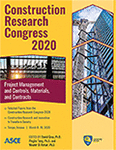Construction Research Congress 2020
Holistic Risk Management Approach for Predicting Cost and Schedule Overruns at Project Completion
Publication: Construction Research Congress 2020: Project Management and Controls, Materials, and Contracts
ABSTRACT
Risk management (RM) technique concentrates on the unknown future performance of projects to determine risks, and it suggests early corrective actions to reduce the impacts of the identified risks. Irrespective of the project properties, cost and schedule growths are substantially experienced in construction projects. Some research works developed models without incorporating any direct relation between different project parameters and the project performance. Moreover, other research studies utilized inputs that fall short in covering the varied risks present in construction projects. To this end, no research study is perceived to have established an integrated methodology to predict the performance of construction projects. As such, this paper presents a holistic RM model to predict the project performance by incorporating a wide spectrum of inputs. The paper relies on 25 parameters that are believed to be the most prominent variables affecting the performance of construction projects. These variables were incorporated into a survey to study their effects on project performance. The collected data was used to fit statistical distributions for each parameter. Based on a mapping between the fitted distributions of the 25 parameters and those of the cost and schedule overruns, this research work was able to propose a new RM model that is easily used to predict project performance in terms of cost and time. This research is valuable for the construction industry as it allows decision makers to take corrective actions as well as assessing the impact of such actions on the future performance of projects. Ultimately, project administrators will be able to predict the overall cost and schedule overruns based on various project parameters. This helps in taking the appropriate actions and decisions to ensure smooth delivery and execution of projects.
Get full access to this article
View all available purchase options and get full access to this chapter.
REFERENCES
Abotaleb, I. S., and El-adaway, I. H. (2018). “Managing construction projects through dynamic modeling: Reviewing the existing body of knowledge and deriving future research directions.” Journal of Management in Engineering, 34(6), 04018033.
Agarwal, R., Chandrasekaran, S., and Sridhar, M. (2016). “Imagining construction’s digital future.” McKinsey Productivity Sciences Center. https://www.mckinsey.com/industries/capital-projects-and-infrastructure/our-insights/imagining-constructions-digital-future (July 14, 2019)
APM ‘Association for Project Management’ (2008). “Interfacing Risk and Earned Value Management.” https://www.apm.org.uk/media/7584/irevm-sample-chapter.pdf (Sept. 22, 2018).
CII ‘Construction Industry Institute’. (2009). “The Alberta report: COAA major projects benchmarking summary.” Rep. to Alberta Finance and Enterprise and Construction Owner’s Association of Alberta (COAA), Edmonton, AB, Canada.
El-adaway, I. H., Ali, G., Assaad, R., Elsayegh, A., and Abotaleb, I. S. (2019). “Analytic Overview of Citation Metrics in the Civil Engineering Domain with Focus on Construction Engineering and Management Specialty Area and Its Subdisciplines.” Journal of Construction Engineering and Management, 145(10), 04019060.
Fowler, F. J. (1995). Improving survey questions: Design and evaluation(Vol. 38). Sage.
Hoffman, G. J., Thal, A. E. Jr, Webb, T. S., and Weir, J. D. (2007). “Estimating performance time for construction projects.” Journal of Management in Engineering, 23(4), 193-199.
IR181-2 ‘Implementation Resource 181-2’ (2013). “Integrated Project Risk Assessment.” https://www.construction-institute.org/resources/knowledgebase/knowledge-areas/risk-analysis-for-international-projects-(best-practice)/topics/rt-181/pubs/ir181-2> (July 14, 2019).
Leon, H., Osman, H., Georgy, M., and Elsaid, M. (2017). “System dynamics approach for forecasting performance of construction projects.” Journal of Management in Engineering, 34(1), 04017049.
Marle, F., and Vidal, L. A. (2016). Managing Complex, High-Risk Projects. London: Springer.
Mills, A. (2001). “A systematic approach to risk management for construction.” Structural survey 19, no. 5 (2001): 245-252.
Olawale, Y., and Sun, M. (2012). “PCIM: Project control and inhibiting-factors management model.” Journal of management in engineering, 29(1), 60-70.
Sudman, S. (1983). “Applied sampling.” In Rossi, PH, JD Wright and A. B. Anderson (eds.). Handbook of survey research, 146-180.
Terry, S. B., and Lucko, G. (2012). “Algorithm for time-cost tradeoff analysis in construction projects by aggregating activity-level singularity functions.” In Construction Research Congress 2012: Construction Challenges in a Flat World(pp. 226-235).
Information & Authors
Information
Published In
Construction Research Congress 2020: Project Management and Controls, Materials, and Contracts
Pages: 583 - 592
Editors: David Grau, Ph.D., Arizona State University, Pingbo Tang, Ph.D., Arizona State University, and Mounir El Asmar, Ph.D., Arizona State University
ISBN (Online): 978-0-7844-8288-9
Copyright
© 2020 American Society of Civil Engineers.
History
Published online: Nov 9, 2020
Published in print: Nov 9, 2020
Authors
Metrics & Citations
Metrics
Citations
Download citation
If you have the appropriate software installed, you can download article citation data to the citation manager of your choice. Simply select your manager software from the list below and click Download.
